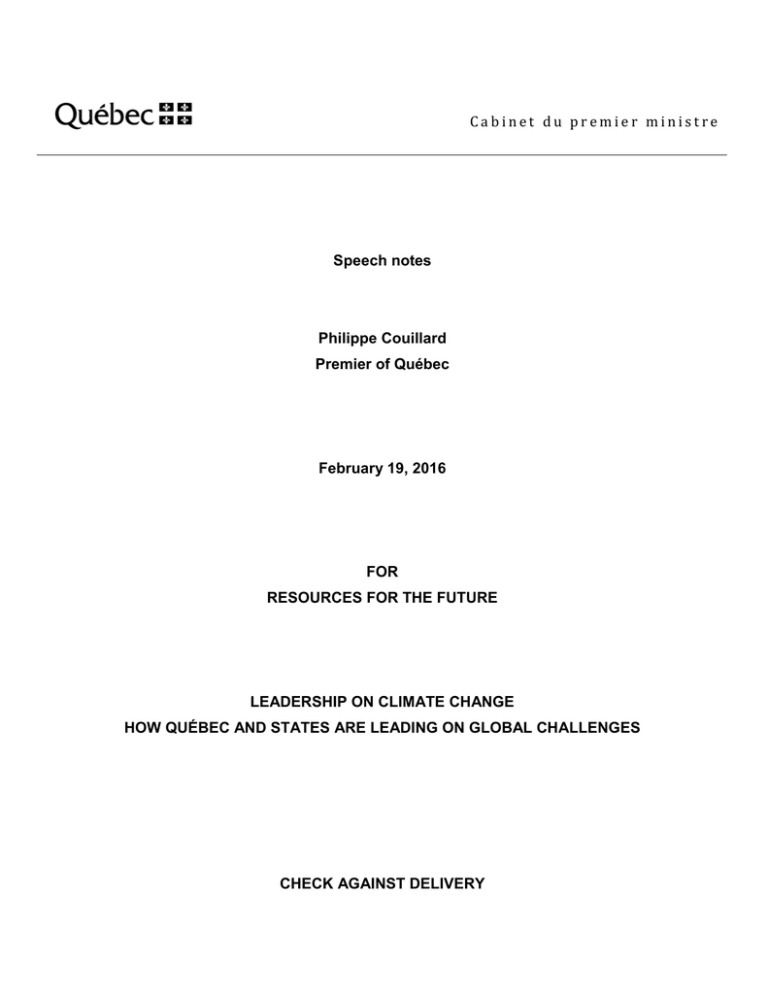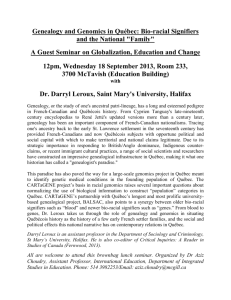Document 11331929
advertisement

Cabinet du premier ministre Speech notes Philippe Couillard Premier of Québec February 19, 2016 FOR RESOURCES FOR THE FUTURE LEADERSHIP ON CLIMATE CHANGE HOW QUÉBEC AND STATES ARE LEADING ON GLOBAL CHALLENGES CHECK AGAINST DELIVERY Mr. Phil Sharp, President of Resources for the Future Mrs Molly Macauley, Vice President for Research and Senior Fellow of Resources for the Future Mr. Delegate general of Quebec to New York Mr. Frederic Tremblay, director of Quebec government office in Washington C’est un plaisir et un honneur que de prendre la parole devant les membres d’un des plus importants think tanks de Washington, qui plus est, une référence en matière d’environnement. It is a pleasure and an honour to speak to the members of one of the most important think tanks in Washington, not to mention, a respected and influential voice in the United States on the environment. We all know that 2015 was, by far, the warmest year since climate data has been recorded. This is one of many examples which illustrate our urgent need to collectively lower our greenhouse gas (GHG) emissions before it is too late. Hydropower With that in mind, Québec has been a leader in the fight against climate change for twenty years. Québec is fortunate that it can rely on a clean and renewable source of energy, with 99% of its electricity generation coming from clean sources. We are proud of our extensive hydropower capacity which we can attribute, in part, to Robert Bourassa. Mr. Bourassa served as Premier of Québec during the seventies and envisioned the potential for hydropower at a time when many were in favour of building a network of nuclear power plants. After all, water covers 12% of our surface area, so his choice to invest in this abundant natural resource was a strategic one. In the 2000s, we invested in wind power, and by 2017, our installed and network-integrated wind power capacity will reach 4,000 MW, which is around 10% of our total electricity production. 46% of the energy consumed today in Québec is from a renewable source, which gives us one of the lowest GHG emission levels in North America, or 9.6 tonnes per capita in 2012. It also gives Québec a comparative advantage in the electrification of transportation. Hydropower stations emit on average 50 times less GHGs than natural gas plants and around 70 times less GHGs than coal-fired plants. And hydropower-related GHG emissions are limited, temporary and non-recurring. Currently the world's fourth largest hydropower producer, Québec has an installed hydropower capacity of 36,000 MW. While pursuing its efforts to promote the efficient use of electricity, Québec is also continuing to build its hydropower production capacity, both for consumption and for export. 2 A clean and reliable energy source, Québec’s hydropower can help neighbouring U.S. states reach their GHG emission reduction targets and lower their carbon footprint. In a book entitled “Power from the North,” Premier Bourassa argued for stronger energy trade relations with our U.S. partners. “One thing is for certain – the need is there and will not subside. The question for the Northeast is whether it will continue its dependence on very expensive forms of energy which may damage the environment and do little to help the economy, or whether the U.S., as it has done so often in the past, will take decisive steps to protect its interests and in this case look to its neighbor to the north for a viable alternative – a neighbor who is already its greatest trading partner and best friend in the world.” Currently, Québec provides around 10% of the electricity consumed in New England and 6% of the electricity in the State of New York. In 2014, our electricity exports to the United States made it possible to prevent the emission of 6.2 million tonnes of CO2, or rougly equivalent to 1.6 million cars. While our existing energy partnership is strong, Québec has the resources to help our U.S. partners go even further. The structure of our network of high-voltage lines, the largest in North America, provides a secure supply of energy. The network was designed to meet peak winter demand, since 75% of Québec’s population heat their homes using electricity. Hydro-Québec, our hydropower public utility, spends over 1.6 billion Canadian dollars annually not only to ensure the reliability of our own network, but also to comply with the same standards (North American Electric Reliability Corporation standards) that are used by the largest American electricity suppliers. Hydropower is extremely versatile. In addition to their reserve capacity, Québec’s large reservoirs can quickly respond, in a matter of minutes, to variations in demand and in the production of intermittent renewable energies, such as wind power. It is easy to store: just by letting water rise behind our dens. Hydropower production is not subject to fluctuations in fossil fuel prices. Long-term supply contracts (which can have flexible provisions) guarantee the supply, regardless of market prices, and grant the same priority enjoyed by Québec customers. However, right now, our U.S. partners can only increase their hydropower imports to a limited extent due to the congestion of transmission lines in the U.S. The construction of new transmission lines would help to stabilize the price of electricity and lower greenhouse gas emissions in the northeastern United States. Connecticut, Massachusetts and Rhode Island, Vermont (long term contract) have all realized this and have in turn launched a competitive bidding process to begin this critical project. 3 At a time when both fossil fuels and nuclear power raise serious concerns, few industrialized countries can count on such abundant clean and renewable resources. The Northeastern United States must take advantage of this strategic partnership with Québec hydropower to meet its own renewable energy goals. Québec and the fight against climate change Our abundant natural resources have certainly benefited our GHG emissions record, but our progress would not be nearly as effective be it not for our collaboration with international partners – especially our American neighbours. Now fifteen years ago, in 2001, New England governors and Eastern Canadian premiers adopted a regional action plan to fight climate change. This action plan set regional GHG reduction targets for 2010, 2020, and 2050. At the time, they were the first group of Federated States to develop such a strategy, progressive action reflective of our forward-looking societies. Keep in mind that this action plan was adopted and implemented four years before the Kyoto Protocol. In 2009, the region more than met the GHG reduction targets it had set for 2010. More recently, the Conference adopted a GHG reduction target of 35% to 45% below 1990 levels for 2030. In 2012, Québec’s measures through its 2006-2012 Climate Change Action Plan helped to reduce its GHG emissions by 8% below 1990 levels. We even surpassed our original targets by 2%. Looking ahead to 2020, Québec aims to reduce its emissions by 20% below 1990 levels, which represents both a challenge for a province where 99% of electricity already comes from clean and renewable sources, and also considerable commercial opportunities, thanks to our expertise that has been developed over the years. For 2030, our target is 37.5% below 1990 levels, and we are committed, as part of the Under 2 MOU initiative, to cutting GHG emissions from 80% to 95% by 2050, as recommended by the Intergovernmental Panel on Climate Change (IPCC) for industrialized countries. The cornerstone of our climate change strategy is our cap and trade system for greenhouse gas allowances, which has been in effect since January 2013 and has been linked to California's system since January 2014. To that affect, Governor Brown is a great partner of ours. It is the first carbon market to be designed and run by states and provinces in different countries and in different political, legal and regulatory contexts. This system guarantees the achievement of emissions reduction targets because the caps are lowered every year to limit GHG emissions levels. This system can reduce GHG emissions at the best possible cost to emitters who now have options, a degree of flexibility and a defined period of time to meet regulatory requirements. This system lets those emitters who exceed their targets sell their excess emissions units on the carbon market. This system also encourages businesses to increase their energy efficiency and use clean energy sources. It ultimately allows them to lower their costs and become more competitive. It stimulates the development of low-carbon technologies and the creation of sustainable green jobs. It promotes the 4 pursuit of economic and environmental goals while preparing for the transition to a low-carbon economy. Before our cap and trade system was even implemented, our government established a continuous dialogue with the private sector through ten sectoral tables that included the representatives of major GHG emitters. It provided them with detailed information about the scope, impacts and advantages of the system, as well as the method used to distribute free emission allowances for industries subject to national and international competition. Several funding programs under the 2013-2020 Climate Change Action Plan (2013-2020 CCAP) are also helping businesses improve their energy efficiency and thus lower their emissions. Our cap and trade system covers nearly 85% of Québec's GHG emissions from large industrial emitters, electricity production and fuel distributors. Auction sales of emission units will ultimately generate over 3 billion Canadian dollars, which will all go to the “Green Fund” and be used to fund the mitigation and adaptation measures included in the 2013-2020 CCAP. To date, the ten auctions, including six held jointly with California, have generated over one billion Canadian dollars for Québec. The success of the Québec-California carbon market is providing the groundwork to develop a larger market. I salute Ontario and Manitoba's plans to join us. Québec is ready to help other Canadian provinces or U.S. states that are thinking about creating a cap and trade system or linking their carbon market with ours. Furthermore, as Co-President of the International Carbon Action Partnership, Québec is already sharing its expertise on setting up a linked carbon market. Ángel Gurría, Secretary-General of the OECD, observed that the Québec-California carbon market is a rare and shining example of how a carbon market should operate. A Chinese delegation came to better understand the workings of our system and benefited from our expertise; we have also signed an information exchange agreement with Mexico. In addition, at the invitation of the World Bank, Québec is participating in several initiatives focused on carbon pricing and market mechanisms, such as the Partnership for Market Readiness and the Carbon Pricing Leadership Coalition. In pursuit of its GHG emission reduction targets, Québec’s proactive leadership has ensured that we are firmly on the path to reducing emissions. The next steps will be more difficult, yet we are prepared to face this challenge. Right now, nearly 45% of our emissions are related to transportation. Therefore, to make a significant impact in this sector, the government has made the electrification of transportation one of its priorities. Under our 2015-2020 Transportation Electrification Action Plan, we plan to invest 420 million dollars by 2020 in order to get 100,000 rechargeable electric and hybrid cars on our roads, out of a car population of over five million. Québec already has enough electricity to power one million electric vehicles, making the choice of choosing electricity over gas an easy one. 5 Québec was the first province to implement financial assistance programs for electric vehicle buyers. There are already children in Québec who have never been in a gas-powered vehicle. To them, a car needs to be plugged in, just like fridge or TV sets. These same children ride to school in electric buses. Lion Bus, based in Québec, is the first manufacturer in North America of fully electric 70-seat school buses. In 2015, nearly half of the rechargeable electric and hybrid passenger cars sold in Canada were sold in Québec. At the end of 2016, we will have deployed 800 charging stations across Québec, including 60 fast chargers. We also support employers in setting up stations at work places. Partnerships have been developed with northeastern U.S. states to create cross-border electric charging circuits, such as the electric charging corridor from Montréal to Burlington, which is already up and running. Governor Peter Shumlin is a great partner… let’s make sure that soon we will be able to drive from Montréal to Boston without gasoline. Furthermore, Québec intends to develop a solid industrial ecosystem by supporting projects and continuing to attract international players in the field of electric transportation. We have a complete value chain in electric transportation, another reason why we are an ideal partner. We already have lithium mines in development and businesses that are active in manufacturing of high-capacity batteries and material components, electric engines, light materials and electric charging stations. I should also mention that we have small-volume assemblers of electric subway cars, hybrid buses and low-speed electric vehicles. We have formed a partnership, which was announced in Davos, with two French companies, Exagon and Peugeot, to carry out a study on the manufacturing of electric car components. We are hopeful that the result will inspire the French car manufacturer to set up an electric car assembly plant in Québec and benefit from our green business environment. We also plan to support urbanization models that encourage sustainable transit habits, such as the densification and organization of TODs (transit-oriented developments), and bolster urban planning approaches that give priority to ecomobility. Transportation electrification will involve both passenger cars and the renewal of mass transit infrastructures. Already, 50% of transit in the mass transit network is electrically powered. Thanks to our strengths in this sector, Québec will host the World Electric Vehicle Symposium and Exhibition, an international transportation electrification conference, in June, in Montréal. Finally, ten years after adopting the 2006-2015 Québec Energy Strategy, Québec has decided to review its energy priorities and directions and will soon publish a new energy policy for the 2016-2030 period, which will be aligned with the GHG emission reduction target of 37.5% by 2030. 6 It will aim to improve energy efficiency, reduce the quantity of oil products consumed, eliminate the use of thermal coal, and increase bioenergy and, more generally, clean energy production. Energy efficiency, energy substitution and behavioural changes are the three pillars of the energy transition required to reach these targets. And to world is changing. The business community, even the financial market, is shifting. The trend is clear. In Québec we understand this shift and we are adapting to it very quickly with a sense of purpose and cohesion. Our economic and energy policies now consider climate change initiatives. These three elements go hand in hand. Energy policy: increase the share of renewable energy in our portfolio Climate change initiatives: to meet our obligations to ourselves as well at others around the world – specifically our children. Economic policy: - Investment criteria now include the environment – sustainability - Countries and businesses are searching for solutions to reduce GHG emissions – innovation - While creating new high quality job for our citizens Now, more than ever, what is good for the environment will also be great for business. Paris Climate Conference We closed 2015 with the Paris Climate Conference. I had the pleasure of participating in a number of meetings, panels and forums, thanks in large part to the alliances that Québec has successfully built as part of its active climate diplomacy over the last 15 years. As a province, it was important for Québec to be in Paris for this moment. In tackling climate change, it is particularly appropriate for Federated States to have a seat at the table. GHG-emitting sectors, including transportation, public works and industry, are often the responsibility of state and provincial governments. We are drafting and enforcing laws, policies, standards, programs and fiscal mechanisms in the areas that influence emission levels, such as energy, environment, transportation, industry, agriculture and land management. And we are dealing with the consequences of crises associated with climate change every day. At the Conference in Paris, Québec helped gain formal recognition of the role and involvement of Federated States in the fight against climate change. It also successfully worked with the Canadian 7 federal government to ensure that the Paris agreement sends a positive message concerning the use of market mechanisms. In addition, Québec made climate cooperation a new part of its international activities by announcing a series of new measures in Paris. The first measure is to strengthen the capacity of the most vulnerable French-speaking countries to meet climate change challenges through clean technology-based projects and expertise in adapting and reducing GHG emissions. Second, we will also contribute to multilateral climate finance by making a contribution to the Least Developed Countries Fund of the Global Environment Facility, which will finance the development and implementation of national adaptation programs. Since climate finance is usually the responsibility of the countries that are parties to the Convention, this initiative sets a precedent to pave the way, we hope, for similar contributions from other Federated States and regional actors. The third measure is to strengthen the capacity of the most vulnerable French-speaking countries to negotiate in French and implement their own climate commitments. As part of this measure, Québec will support actions by young people, who make up a growing percentage of the population in regions where climate change will affect them disproportionately. To our great satisfaction, the Paris Agreement is the product of a balanced, flexible and ambitious consensus that reflects today's reality but also looks ahead to tomorrow’s reality. Finally, I would like to pay tribute to the leadership shown by the United States in reaching such a crucial agreement, an essential step in collectively securing our planet’s future. Distinguished guests, dear friends, Today, we know that what is good for the climate is also good for business. Our businesses can modernize the world and reap substantial benefits in doing so. Today we know that socially responsible behaviour is a condition for success. And most countries, no matter how much they welcome capital, are tightening their standards now that they understand the obvious need for sustainable development. Today we know that risk management now includes climate risk and will to increasingly take into account the tendency of certain funds to withdraw or limit investments in carbon intensive companies. We urgently need to adopt eco-friendly technologies at a much faster rate and set up an effective environment for creating millions of green jobs. We must focus on transitioning to a low-carbon economy. We can proactively choose to do so now. Or we can wait, and let others reap the benefits. Far from being an obstacle to growth, the fight against climate change will shape the economy of the 21st century, just like coal did in the 19th century and oil did in the 20th. Innovative businesses have always adapted, found solutions and developed products and services. 8 Today, the businesses and societies whose vision is adapted to the environmental challenges will be the big winners. Québec plans to be one of them. Aujourd’hui, ce sont les entreprises et les sociétés à la vision adaptée aux défis environnementaux qui en sortiront les grandes gagnantes. Le Québec entend bien en faire partie. I thank you for your attention, and I look forward to the discussion. 9






